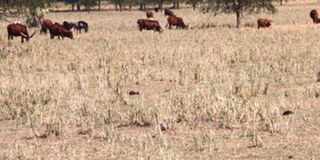Brace for dry spell, weatherman warns

Cattle feed on dry grass during the dry season in Butungama Parish, Rwebisengo Sub-county in Ntoroko District in 2012. PHOTO | FILE
What you need to know:
- The Uganda National Meteorological Authority has released its weather report for February. In this explainer, Mudangha Kolyangha unpacks what is in the report.
The Uganda National Meteorological Authority (UNMA) has issued its forecast for February, predicting that most parts of the country will experience dry weather conditions.
What weather conditions should we brace ourselves for this month?
UNMA predicts that the country is expected to be much warmer than average. While sunny and dry conditions are expected to dominate, the authority’s latest report highlights potential impacts on various sectors and other crucial advisories for communities. The climate outlook for February 2024 and rainfall performance for January 2024 indicates that most parts of the country are likely to remain generally dry and sunny with hazy conditions.
However, occasional rainfall is expected in southwestern and around the Lake Victoria basin. Generally, temperatures are expected to be warmer than average over most parts of the country.
Will hot conditions persist throughout all four corners of the country?
Not really. During January 2024, substantial rainfall was experienced in Kigezi, the Lake Victoria basin, and eastern parts of the country. February will be the polar opposite. This is hardly new. High, dry temperatures and higher-than-average temperatures are usually recorded during February.
The outlook for February indicates a likelihood of dry, sunny, and hazy conditions to persist over most parts of the country. However, southwestern parts of the country are likely to experience wetter conditions while isolated parts around the central, specifically Lake Victoria basin, stretching to the eastern region are expected to experience occasional rainfall.
UNMA says during February, maximum temperatures are expected to soar to the range of 30°C to 32°C and even higher in the northern, eastern, and around Kyoga basin regions.
“Other parts of the country can anticipate temperatures ranging from 24°C to 28°C. Notably, highland areas such as Rwenzori, Elgon, and Kigezi are projected to experience cooler temperatures ranging from 8°C to 22°C,” Bob Alex Ogwang, UNMA’s executive director, reveals.
He adds: “The mean temperature for February is expected to range from 24°C to 28°C in the northern half and from 20°C to 24°C in the southern half. However, the western rift valley areas are predicted to experience even higher temperatures ranging from 28°C to 30°C.”
What are the factors behind the anticipated hot weather?
These temperature projections stem from various climate drivers influencing Uganda’s weather patterns in February. Factors such as the prevailing El Niño conditions, equatorial sea surface temperatures, Indian Ocean Dipole, and the influence of high-pressure systems alongside local geographical features all contribute to shaping the country’s climate outlook.
“The persistent dry conditions coupled with high temperatures may lead to increased incidents of respiratory and eye diseases due to dusty and windy conditions,” Mr Ogwang says. He adds: “Furthermore, reduced pastures for animals and potential water resource depletion could aggravate human-wildlife conflicts and agricultural challenges […] there is a heightened risk of malaria outbreaks due to favourable conditions for mosquito breeding.”
How will the hot weather affect us?
Per the meteorological authority, the January to February period constitutes the major dry season in Uganda. It is characterised by warmer day-time temperature values and hazy conditions. The backend of February, UNMA adds, forms the onset period for the southern parts of the country. The UNMA executive director also adds: “Human-wildlife conflicts may escalate during the season as wild animals migrate in search of water and pasture.”
The government has advised motorists to drive with caution whenever fog and hazy conditions prevail as well as increase surveillance to report any disease incidences to the authorities for immediate interventions.




